Diagram Based Questions: Light - Reflection and Refraction | Science Class 10 PDF Download
Q1: Answer the following questions based on the diagram given below:
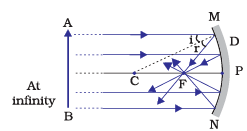
(i) What is a converging mirror, and how does it differ from a diverging mirror?
Ans: A converging mirror, also known as a concave mirror, is a curved mirror with an inward-curved reflecting surface. It reflects light rays in such a way that they converge or come together at a point. In contrast, a diverging mirror (convex mirror) has an outward-curved reflecting surface and causes light rays to diverge or spread out.
(ii) Explain how the image formed by a converging mirror depends on the object's distance from the mirror.
Ans: The image formed by a converging mirror can be real or virtual, depending on the object's position:
- When the object is placed beyond the mirror's focal point (F), a real and inverted image is formed.
- When the object is placed between the focal point (F) and the mirror, a virtual and upright image is formed.
- If the object is placed at the focal point (F), no image is formed, and the rays are parallel after reflection.
(iii) How can you determine the focal length of a converging mirror experimentally?
Ans: The focal length of a converging mirror can be determined experimentally using the "two-ray method." This involves:
- Placing an object (such as a candle) in front of the mirror at a known distance.
- Marking the location of the image formed by the mirror.
- Measuring the object distance (u) and the image distance (v).
- Using the mirror formula, 1/f = 1/v + 1/u, to calculate the focal length (f).
(iv) Explain the term "principal focus" of a converging mirror.
Ans: The principal focus of a converging mirror (concave mirror) is a point on its principal axis where parallel rays of light, when incident on the mirror, converge or appear to converge after reflection. It is denoted as "F" and is one-half of the focal length. Rays parallel to the principal axis are reflected through this point after interacting with the mirror.
(v) State one common use of a converging mirror in everyday life.
Ans: One common use of a converging mirror is in makeup mirrors or shaving mirrors. Converging mirrors produce upright and virtual images, making it easier to see a magnified view of one's face while applying makeup or shaving. This allows for a more detailed and accurate reflection.
Q2: Answer the following questions based on the diagram given below:
(i) What is the shape of a diverging mirror?
Ans: A diverging mirror has a curved reflective surface that bulges outward, giving it a shape similar to the outer surface of a sphere. It is also called a convex mirror.
(ii) How does the image formed by a diverging mirror differ from that formed by a converging mirror?
Ans: The image formed by a diverging mirror is virtual, erect (upright), and diminished (smaller in size) compared to the object. In contrast, a converging mirror (concave mirror) can form real or virtual images, which can be either magnified or diminished depending on the object's position.
(iii) What happens to the rays of light that strike a diverging mirror?
Ans: When parallel rays of light strike a diverging mirror, they diverge or spread out, reflecting away from each other. This is why it's called a diverging mirror.
(iv) Explain how the image position changes when you move an object closer to a diverging mirror.
Ans: As you move an object closer to a diverging mirror, the virtual image formed by the mirror moves farther away from the mirror and becomes smaller in size. The image remains virtual and erect.
(v) What are some real-world applications of diverging mirrors?
Ans: Diverging mirrors are commonly used in side mirrors of vehicles such as cars and bikes. They provide a wide field of view, allowing the driver to see objects behind and to the sides of the vehicle. The smaller and erect virtual image helps in judging the relative positions of objects in traffic.
Q3: Answer the following questions based on the diagram given below: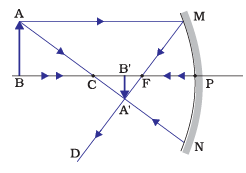
(i) What happens to the image when the object is placed at the center of curvature (C) of a concave mirror?
Ans: When the object is placed at the center of curvature (C) of a concave mirror, the image is formed at the same location, also at the center of curvature. The image is real, inverted, and of the same size as the object.
(ii) How does the size of the image formed by a concave mirror change when the object is moved from C towards the focus (F)?
Ans: As the object is moved from C towards the focus (F) of a concave mirror, the size of the image gradually increases. It becomes larger than the object, but it remains real and inverted.
(iii) What happens to the image formed by a concave mirror when the object is placed between the center of curvature (C) and the focus (F)?
Ans: When the object is placed between the center of curvature (C) and the focus (F) of a concave mirror, the image is formed beyond the center of curvature. It is real, inverted, and magnified.
(iv) Describe the nature of the image formed by a concave mirror when the object is placed at the focus (F).
Ans: When the object is placed at the focus (F) of a concave mirror, no real image is formed. Instead, the reflected rays appear to diverge from the mirror, and they do not meet. Therefore, the image is said to be formed at infinity, and it is highly magnified.
(v) What happens to the image formed by a concave mirror when the object is moved closer to the mirror beyond the focus (F)?
Ans: When the object is moved closer to the mirror beyond the focus (F) of a concave mirror, the image is formed on the same side as the object, and it appears to be virtual, erect, and highly magnified. It cannot be obtained on a screen.
Q4: Answer the following questions based on the diagram given below: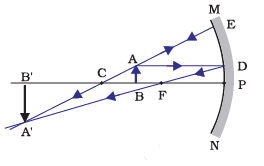
(i) What happens to the rays of light when an object is placed at the focal point (F) of a concave mirror?
Ans: When an object is placed at the focal point (F) of a concave mirror, the rays of light become parallel after reflection.
(ii) Describe the type of image formed when an object is placed at the focal point (F) of a concave mirror.
Ans: When an object is placed at the focal point (F) of a concave mirror, no real image is formed. Instead, the reflected rays diverge and appear to be coming from a point behind the mirror. This virtual image is highly magnified and cannot be projected onto a screen.
(iii) How does the image formed when an object is placed at the center of curvature (C) of a concave mirror differ from other positions?
Ans: When an object is placed at the center of curvature (C) of a concave mirror, the image formed is real, inverted, and of the same size as the object. It is also located at the same distance as the object but on the opposite side of the mirror.
(iv) What is the principal focus of a concave mirror, and how is it related to the focal length?
Ans: The principal focus of a concave mirror is the point where parallel rays of light either converge (in the case of a concave mirror) or appear to diverge from (in the case of a convex mirror) after reflection. The focal length (f) is the distance between the mirror's pole and its principal focus. In a concave mirror, the focal length is positive.
(v) Explain why a concave mirror is called a converging mirror and give an example of its real-world use.
Ans: A concave mirror is called a converging mirror because it brings parallel rays of light together after reflection. An example of its real-world use is in a makeup mirror, where it is used to form a magnified and clear virtual image of the face, allowing for precise makeup application.
Q5: Answer the following questions based on the diagram given below:

(i) What happens when an object is placed at the focus (F) of a concave mirror?
Ans: When an object is placed at the focus (F) of a concave mirror, no real image is formed. Instead, the rays of light diverge and appear to be coming from behind the mirror. This image is virtual, erect, and highly magnified.
(ii) How does the size of the image formed when the object is at the focus compare to the size of the object?
Ans: When the object is placed at the focus (F) of a concave mirror, the size of the image becomes infinitely large or highly magnified compared to the size of the object.
(iii) Where is the image formed when the object is placed between the focus (F) and the pole (P) of a concave mirror?
Ans: When the object is placed between the focus (F) and the pole (P) of a concave mirror, the image is formed on the same side as the object. It is virtual, erect, and magnified.
(iv) How does the nature of the image change as the object moves from beyond the focus to between the focus and the pole?
Ans: As the object moves from beyond the focus towards the focus and between the focus and the pole, the image changes from being real, inverted, and diminished to being virtual, erect, and magnified.
(v) What is the special point of a concave mirror where the incident rays converge or appear to converge after reflection?
Ans: The special point of a concave mirror where incident rays either converge or appear to converge after reflection is called the focus (F) of the mirror. It is one of the key characteristics of a concave mirror's behavior.
Q6: Answer the following questions based on the diagram given below:

(i) What is the type of mirror used in this experiment, and how can you identify it?
Ans: The type of mirror used in this experiment is a convex mirror. You can identify it by its outward-curved reflective surface, which bulges outward like the back of a spoon.
(ii) Where is the object placed in this experiment when it is said to be "placed at P"?
Ans: When the object is said to be "placed at P," it is positioned at the principal focus (F) of the convex mirror.
(iii) What happens to the rays of light that strike the convex mirror when the object is placed at infinity?
Ans: When the object is placed at infinity, parallel rays of light from the object strike the convex mirror and appear to diverge after reflection. These diverging rays appear to originate from the principal focus (F) of the convex mirror.
(iv) Describe the nature and characteristics of the image formed when the object is placed at infinity in front of a convex mirror.
Ans: When the object is placed at infinity in front of a convex mirror, the image formed is virtual, erect, diminished in size, and located at the principal focus (F) behind the mirror. It is a point-sized image.
(v) How does the size of the image compare to the size of the object when the object is placed at infinity in front of a convex mirror?
Ans: When the object is placed at infinity in front of a convex mirror, the size of the image is smaller than the size of the object. The image is diminished in size, appearing as a point.
Q7: Answer the following questions based on the diagram given below:
(i) What is the purpose of the experiment involving the refraction of light through a rectangular glass slab?
Ans: The purpose of this experiment is to observe and understand how light changes its path when it passes through a rectangular glass slab due to refraction.
(ii) What are the two main observations made in this experiment?
Ans: The two main observations are:
- The incident ray of light deviates or changes its direction when it enters the glass slab.
- The emergent ray of light deviates again when it exits the glass slab and returns to its original direction.
(iii) Why does the incident ray change its direction when it enters the glass slab?
Ans: The incident ray changes its direction due to the difference in the speed of light in air and glass. Light slows down when it enters the glass, causing refraction.
(iv) When does the emergent ray of light deviate once more as it exits the glass slab?
Ans: The emergent ray of light deviates when it exits the glass slab if it is incident at an angle other than perpendicular (i.e., not at 90 degrees) to the slab's surfaces.
(v) What happens to the emergent ray if it is incident perpendicular to the glass slab?
Ans: When the incident ray is perpendicular to the glass slab, the emergent ray continues in the same direction without deviating. There is no lateral shift observed in this case.
Q8: Answer the following questions based on the diagram given below:
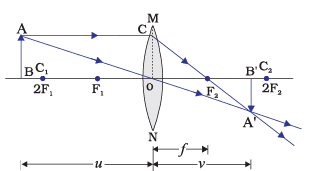
(i) What happens to the image when the object is placed beyond 2F1 for a convex lens?
Ans: When the object is placed beyond 2F1 for a convex lens, a real and inverted image is formed on the opposite side of the lens on the screen.
(ii) How does the size of the image compare to the size of the object when the object is placed beyond 2F1?
Ans: When the object is placed beyond 2F1, the size of the image is smaller than the size of the object
(iii) Where is the image formed in relation to the lens when the object is placed beyond 2F1?
Ans: The image is formed on the same side as the object (the side facing the light source), but it is beyond the 2F1 point on the opposite side of the lens.
(iv) Is the image real or virtual when the object is placed beyond 2F1?
Ans: When the object is placed beyond 2F1, the image formed is real. This means it can be projected onto a screen and can be captured.
(v) What happens to the image distance as the object is moved even farther away from the lens beyond 2F1?
Ans: As the object is moved even farther away from the lens beyond 2F1, the image distance also increases, and the image becomes smaller and more distant from the lens.
Q9: Answer the following questions based on the diagram given below: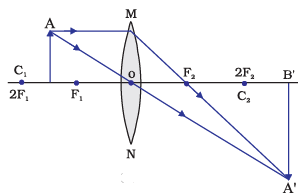
(i) What type of lens is used in this experiment, and how is it different from a concave lens?
Ans: In this experiment, a convex lens is used. A convex lens is thicker at the center and thinner at the edges, whereas a concave lens is thinner at the center and thicker at the edges. This difference in shape causes convex lenses to converge light rays, while concave lenses diverge them.
(ii) Where is the object placed in this experiment, and why is it positioned there?
Ans: The object is placed between 2F1 (twice the focal length) and F1 (the focal length) of the convex lens. This position is chosen because it forms a real and inverted image on the same side as the object. It also allows us to observe various properties of the image formation by a convex lens.
(iii) Describe the nature and characteristics of the image formed in this experiment.
Ans: The image formed is real, inverted, and diminished in size. It is located on the same side as the object, between the focal point (F1) and twice the focal length (2F1). This means that the image is smaller than the object and appears upside down.
(iv) How does the image change when you move the object closer to the lens from the 2F1 position?
Ans: When the object is moved closer to the lens from the 2F1 position, the image also moves closer to the lens on the same side as the object. The image size increases, but it remains real, inverted, and on the same side as the object.
(v) What happens to the image if the object is moved beyond 2F1 away from the lens?
Ans: If the object is moved beyond 2F1 away from the lens, the image will be formed on the opposite side of the lens (the side opposite to the object). It will still be real and inverted, but it will also be larger in size compared to when it was between 2F1 and F1.
|
80 videos|567 docs|80 tests
|
FAQs on Diagram Based Questions: Light - Reflection and Refraction - Science Class 10
| 1. What is the law of reflection? |  |
| 2. How does light undergo refraction? |  |
| 3. What is the difference between regular and diffuse reflection? |  |
| 4. What is the critical angle in refraction? |  |
| 5. How does a prism work in the context of refraction? |  |

















